Carbon Footprint Assessment of Hydrogen and Steel
Abstract
1. Introduction
2. Hydrogen Production
2.1. State of the Art
2.2. Carbon Footprint of Hydrogen from Electrolysis
2.2.1. Goal and Scope
2.2.2. Life Cycle Inventory
2.2.3. Carbon Footprint Results
2.2.4. Future Outlook (2030–2040)
3. Carbon Footprint of Steel Produced Using a Natural Gas-Based Direct Reduction Plant and an Electric Arc Furnace
3.1. Goal and Scope
3.2. Life Cycle Inventory
3.3. Carbon Footprint Results
4. Carbon Footprint of Steel Produced Using a H2-Based Direct Reduction Plant and an Electric Arc Furnace
4.1. Goal and Scope
4.2. Life Cycle Inventory
4.3. Carbon Footprint Results
5. Conclusions
Author Contributions
Funding
Data Availability Statement
Conflicts of Interest
References
- IPCC. Climate Change 2021: The Physical Science Basis. In Contribution of Working Group I to the Sixth Assessment Report of the Intergovernmental Panel on Climate Change; Masson-Delmotte, V., Zhai, P., Pirani, A., Connors, S.L., Péan, C., Berger, S., Caud, N., Chen, Y., Goldfarb, L., Gomis, M.I., Eds.; Cambridge University Press: Cambridge, UK, 2021. [Google Scholar]
- European Union (EU). Communicatio n from the Commission to the European Parliament, the European Council, the Council, the European Economic and Social Committee and the Committee of the Regions. The European Green Deal. 2019. Available online: https://eur-lex.europa.eu/resource.html?uri=cellar:b828d165-1c22-11ea-8c1f-01aa75ed71a1.0002.02/DOC_1&format=PDF (accessed on 21 January 2022).
- Federal Constitutional Court. Constitutional Complaints against the Federal Climate Change Act Partially Successful. 2021. Available online: https://www.bundesverfassungsgericht.de/SharedDocs/Pressemitteilungen/EN/2021/bvg21-031.html. (accessed on 21 January 2022).
- IEA. International Energy Agency: Iron and Steel Technology Roadmap—Towards More Sustainable Steelmaking. 2020, pp. 38–43. Available online: https://iea.blob.core.windows.net/assets/eb0c8ec1-3665-4959-97d0-187ceca189a8/Iron_and_Steel_Technology_Roadmap.pdf (accessed on 21 January 2022).
- Worldsteel Association. Setting the Course for a Healthy Steel Industry. 2020. Available online: https://www.steelforum.org/stakeholders/gfsec-march-2020-worldsteel.pdf (accessed on 11 November 2021).
- Wang, P.; Ryberg, M.; Yang, Y.; Feng, K.; Kara, S.; Hauschild, M.; Chen, W.-Q. Efficiency stagnation in global steel production urges joint supply- and demand-side mitigation efforts. Nat. Commun. 2021, 12, 2066. [Google Scholar] [CrossRef]
- Wörtler, M.; Schuler, F.; Voigt, N.; Schmidt, T.; Dahlmann, P.; Lüngen, H.B.; Ghenda, J. Steel’s Contribution to a Low-Carbon Europe 2050. Technical and Economic Analysis of the Sector’s CO2 Abatement Potential. 2013. Available online: https://www.stahl-online.de/wp-content/uploads/Schlussbericht-Studie-Low-carbon-Europe-2050_-Mai-20131.pdf (accessed on 10 December 2022).
- DIN EN ISO 14040:2006 + Amd 1:2020; Environmental Management—Life Cycle Assessment—Principles and Framework. ISO: Geneva, Switzerland, 2006.
- DIN EN ISO 14044:2006 + Amd 1:2017 + Amd 2:2020; Environmental Management—Life Cycle Assessment—Requirements and Guidelines. ISO: Geneva, Switzerland, 2006.
- DIN EN ISO 14067:2019-02; Greenhouse Gases—Carbon Footprint of Products—Requirements and Guidelines for Quantification. ISO: Geneva, Switzerland, 2019.
- ©Sphera Solutions GmbH. Gabi Database 2021.1. List of Databases. 2021. Available online: https://gabi.sphera.com/databases/gabi-data-search/ (accessed on 10 December 2022).
- Suer, J.; Traverso, M.; Ahrenhold, F. Carbon footprint of scenarios towards climate-neutral steel according to ISO 14067. J. Clean. Prod. 2021, 318, 128588. [Google Scholar] [CrossRef]
- Liu, W.; Zuo, H.; Wang, J.; Xue, Q.; Ren, B.; Yang, F. The production and application of hydrogen in steel industry. Int. J. Hydrogen Energy 2021, 46, 10548–10569. [Google Scholar] [CrossRef]
- Agora Energiewende. Klimaneutrale Industrie. Schlüsseltechnologien und Politikoptionen für Stahl, Chemie und Zement. Berlin. November 2019. Available online: https://www.agora-energiewende.de/veroeffentlichungen/klimaneutrale-industriehauptstudie/ (accessed on 8 March 2022).
- Midrex Technologies, Inc. Direct from Midrex, 2nd Quarter. 2019. Available online: http://www.midrex.com/wp-content/uploads/Midrex_2019_DFM2QTR_Final.pdf (accessed on 23 November 2022).
- Suer, J.; Traverso, M.; Jäger, N. Review of Life Cycle Assessments for Steel and Environmental Analysis of Future Steel Production Scenarios. Sustainability 2022, 14, 14131. [Google Scholar] [CrossRef]
- Duarte, P.E.; Becerra, J.; Lizcano, C.; Martinis, A. ENERGIRON direct reduction technology-economical, flexible, environmentally friendly. Acero Lat. 2008, 6, 52–58. [Google Scholar]
- Federal Ministry of Education and Research. Eine kleine Wasserstoff-Farbenlehre. 2021. Available online: https://www.bmbf.de/de/eine-kleine-wasserstoff-farbenlehre-10879.html (accessed on 21 January 2022).
- IEA. International Energy Agency: Hydrogen—Fuels & Technologies—IEA. 2021. Available online: https://www.iea.org/fuels-and-technologies/hydrogen (accessed on 21 January 2022).
- Dena. Deutsche Energie-Agentur GmbH (dena)—German Energy Agency. Sustainable Electricity Sources. Renewable Fuels of Non-Biological Origin in the RED II. 2020. Available online: https://www.dena.de/test/user_upload/Sustainable_Electricity_Sources_Position_Paper_2020-07.pdf (accessed on 21 January 2022).
- Hölling, M.; Schäfers, H.; Gellert, S.; Grasenack, M.; Jürgens, L.; Tedjosantoso, N.; Schüttler, S. WiSaNo—Windstahl aus Norddeutschland. Technical Report. 2021. Available online: https://germany.arcelormittal.com/icc/arcelor/med/f53/f53689fc-e1fa-9718-60c5-e74064a585a0,11111111-1111-1111-1111-111111111111.pdf (accessed on 10 December 2022). [CrossRef]
- Ozbilen, A.; Dincer, I.; Rosen, M.A. A comparative life cycle analysis of hydrogen production via thermochemical water splitting using a Cu–Cl cycle. Int. J. Hydrogen Energy 2011, 36, 11321–11327. [Google Scholar] [CrossRef]
- Cetinkaya, E.; Dincer, I.; Naterer, G. Life cycle assessment of various hydrogen production methods. Int. J. Hydrogen Energy 2011, 37, 2071–2080. [Google Scholar] [CrossRef]
- Antonini, C.; Treyer, K.; Streb, A.; van der Spek, M.; Bauer, C.; Mazzotti, M. Hydrogen production from natural gas and biomethane with carbon capture and storage—A techno-environmental analysis. Sustain. Energy Fuels 2020, 4, 2967–2986. [Google Scholar] [CrossRef]
- Mehmeti, A.; Angelis-Dimakis, A.; Arampatzis, G.; McPhail, S.J.; Ulgiati, S. Life Cycle Assessment and Water Footprint of Hydrogen Production Methods: From Conventional to Emerging Technologies. Environments 2018, 5, 24. [Google Scholar] [CrossRef]
- Bukold, S.; Huneke, F.; Claußner, M. Studie Grün oder Blau? Wege in die Wasserstoff-Wirtschaft 2020 bis 2040. 2020. Available online: https://green-planet-energy.de/fileadmin/docs/pressematerial/Gruen_oder_blau_Wege_in_die_Wasserstoffwirtschaft_final.pdf (accessed on 10 December 2022).
- Vickers, J. Current Central Hydrogen from Coal with CO2 Capture and Sequestration version 3.2018. 2019. Available online: https://www.nrel.gov/hydrogen/h2a-production-models.html (accessed on 21 January 2022).
- Bartlett, J.; Krupnick, A. Resources for the Future Report: Decarbonized Hydrogen in the US Power and Industrial Sectors: Identifying and Incentivizing Opportunities to Lower Emissions. 2020. Available online: https://www.rff.org/publications/reports/decarbonizing-hydrogen-us-power-and-industrial-sectors/ (accessed on 21 January 2022).
- van Cappellen, L.; Croezen, H.; Rooijers, F. Feasibility Study into Blue Hydrogen. Technical, Economic & Sustainability Analysis. CE Delft. 2018. Available online: https://cedelft.eu/wp-content/uploads/sites/2/2021/04/CE_Delft_9901_Feasibility_study_into_blue_hydrogen_DEF_bak.pdf (accessed on 21 January 2022).
- Howarth, R.W.; Jacobson, M.Z. How green is blue hydrogen? Energy Sci. Eng. 2021, 9, 1676–1687. [Google Scholar] [CrossRef]
- Dawood, F.; Anda, M.; Shafiullah, G.M. Hydrogen Production for Energy: An Overview. Int. J. Hydrog. Energy 2020, 45, 3847–3869. [Google Scholar] [CrossRef]
- Office of Energy Efficiency & Renewable Energy. Safe Use of Hydrogen. 2022. Available online: https://www.energy.gov/eere/fuelcells/safe-use-hydrogen (accessed on 21 November 2022).
- IEA. International Energy Agency: Electricity Generation by Source. 2018. Available online: https://www.iea.org/countries (accessed on 21 January 2022).
- IEA. International Energy Agency: World Energy Outlook (2020); OECD Publishing: Paris, France, 2020. [Google Scholar] [CrossRef]
- Prognos, Öko-Institut, Wuppertal-Institut. Klimaneutrales Deutschland. Studie im Auftrag von Agora Energiewende, Agora Verkehrswende und Stiftung Klimaneutralität. 2020. Available online: https://www.agora-energiewende.de/veroeffentlichungen/klimaneutrales-deutschland/ (accessed on 21 January 2022).
- Prognos, A.G. Kosten und Transformationspfade für strombasierte Energieträger. With assistance of Kreidelmeyer, S.; Dambeck, H.; Kirchner, A.; Wünsch, M. 2020. Available online: https://www.bmwi.de/Redaktion/DE/Downloads/Studien/transformationspfade-fuer-strombasierte-energietraeger.pdf?__blob=publicationFile (accessed on 21 January 2022).
- World Steel Association. Life Cycle Assessment Methodology Report; World Steel Association: Brussels, Belgium, 2011. [Google Scholar]
- Sarkar, S.; Bhattacharya, R.; Roy, G.G.; Sen, P.K. Modeling MIDREX Based Process Configurations for Energy and Emission Analysis. Steel Res. Int. 2017, 89. [Google Scholar] [CrossRef]
- Barati, M. Energy intensity and greenhouse gases footprint of metallurgical processes: A continuous steelmaking case study. Energy 2010, 35, 3731–3737. [Google Scholar] [CrossRef]
- Cardenas, J.G.G.; Conejo, A.N.; Gnechi, G.G. Optimization of energy consumption in electric arc furnaces operated with 100% DRI. Metal 2007, 2017, 1–7. [Google Scholar]
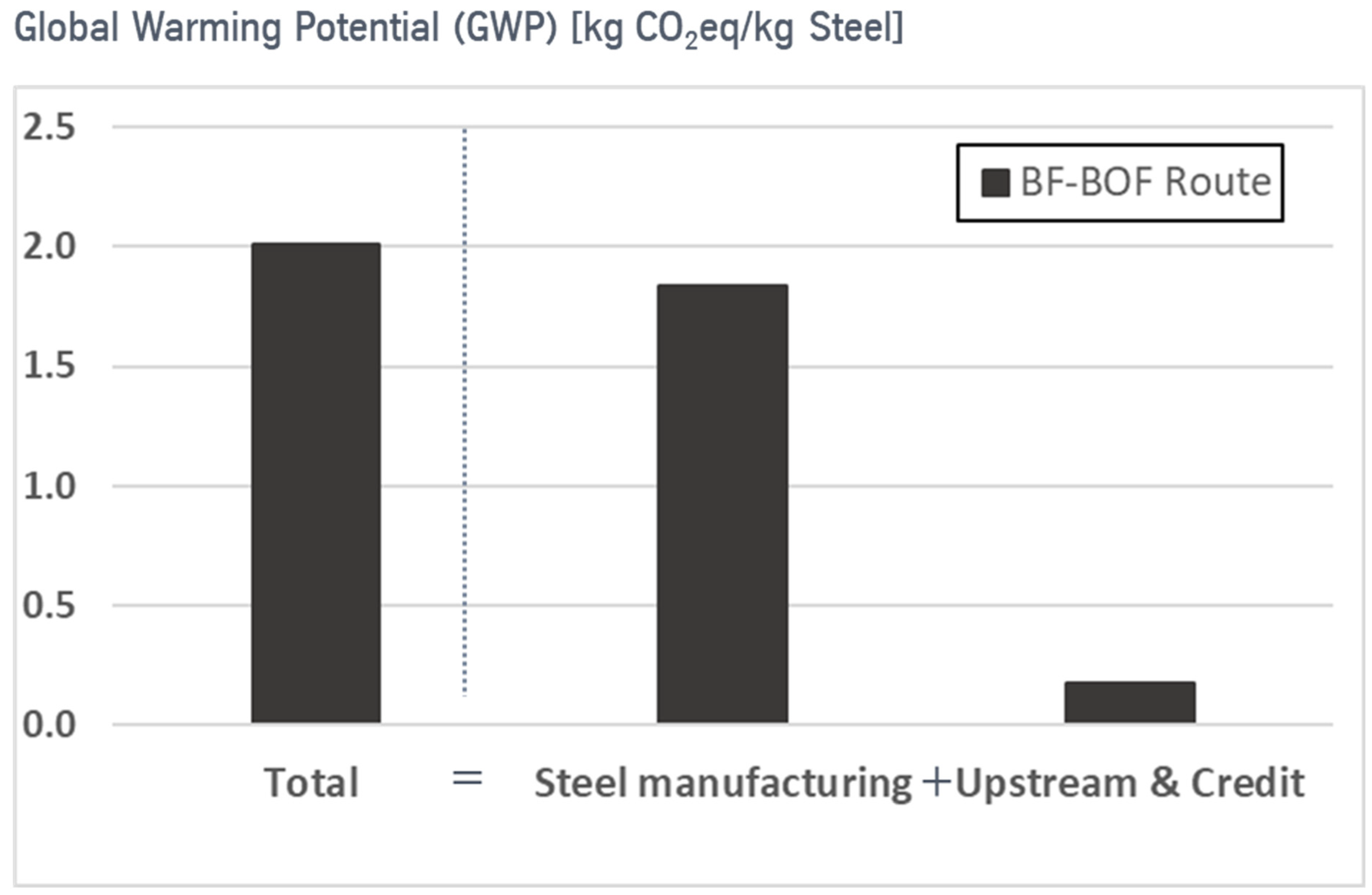
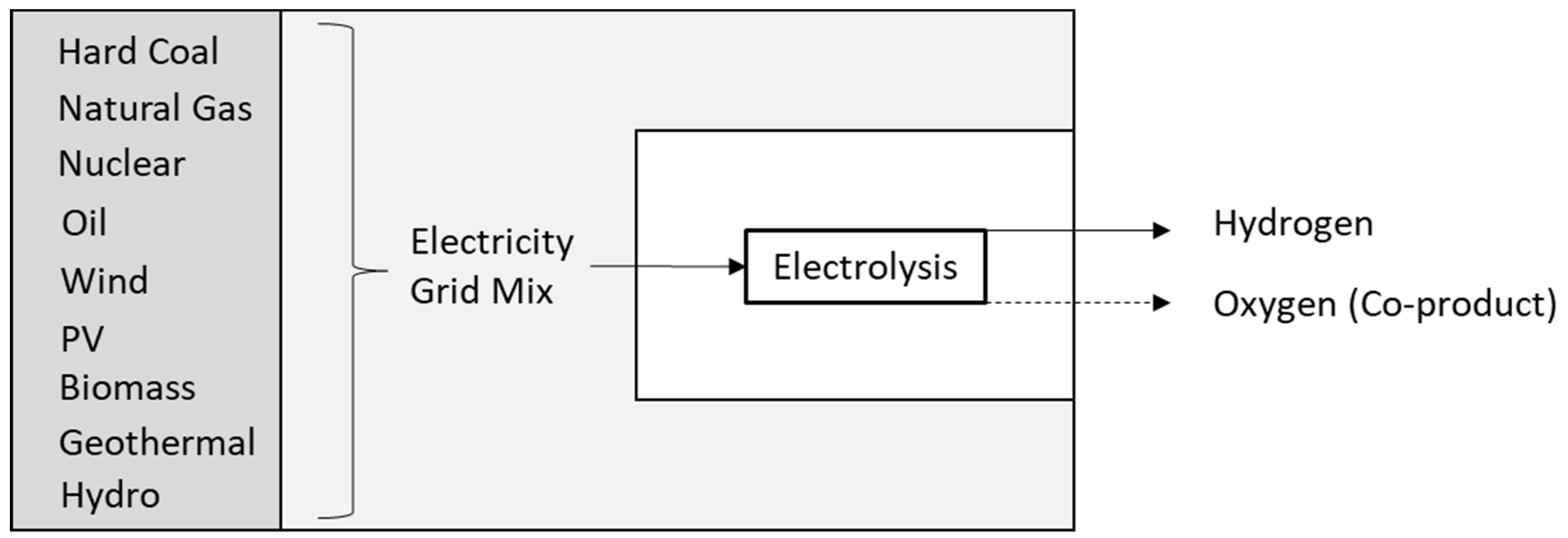
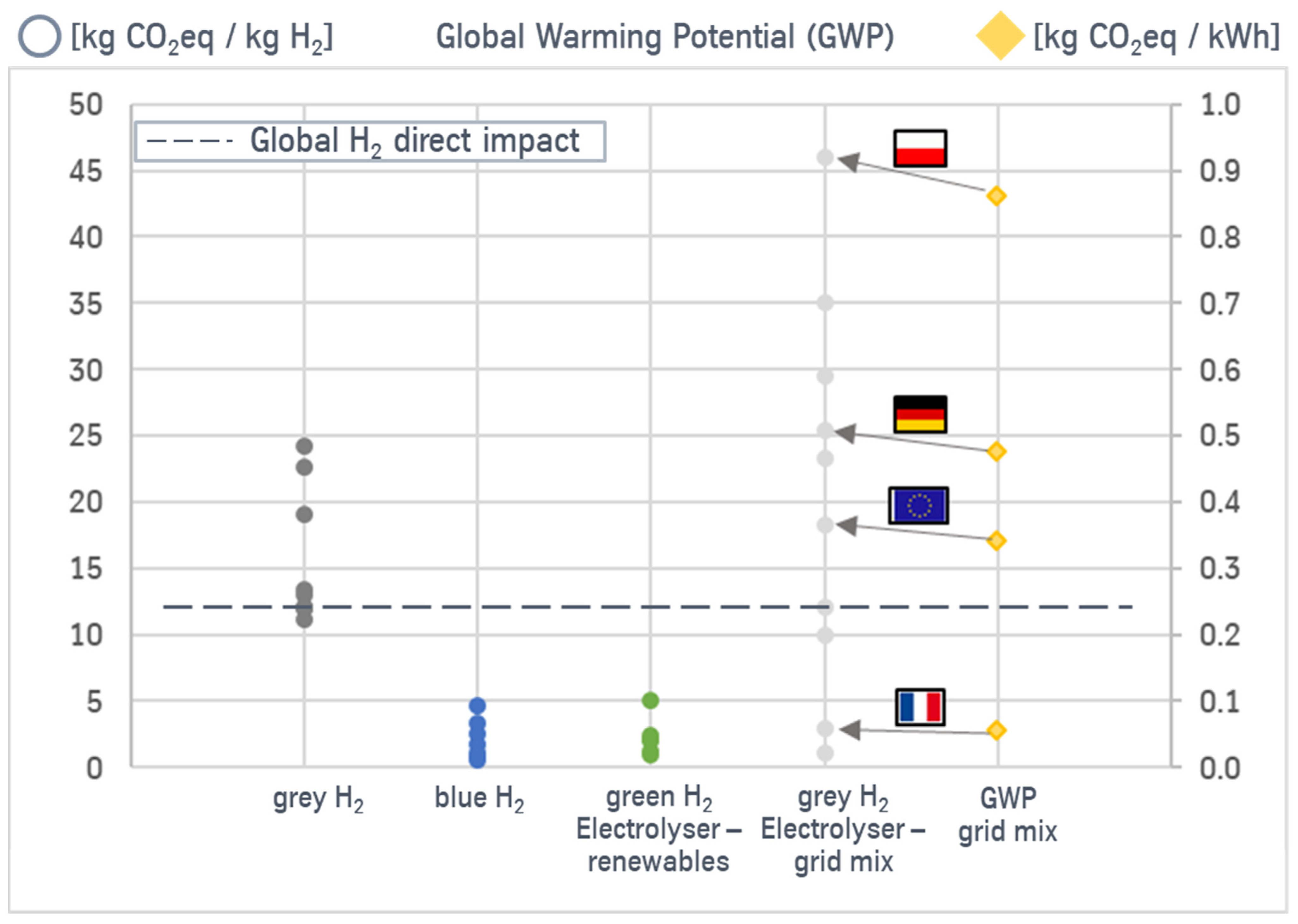
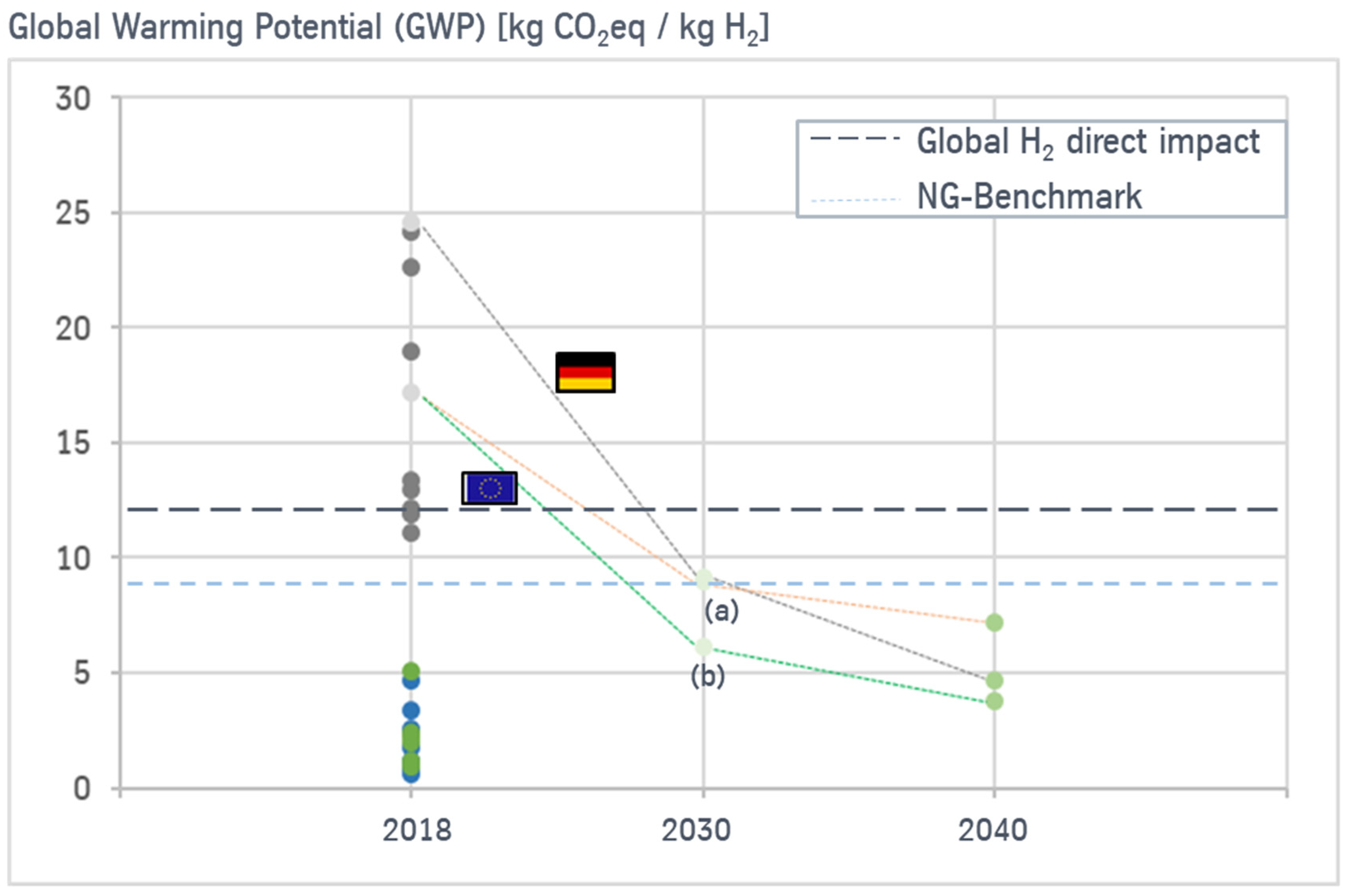
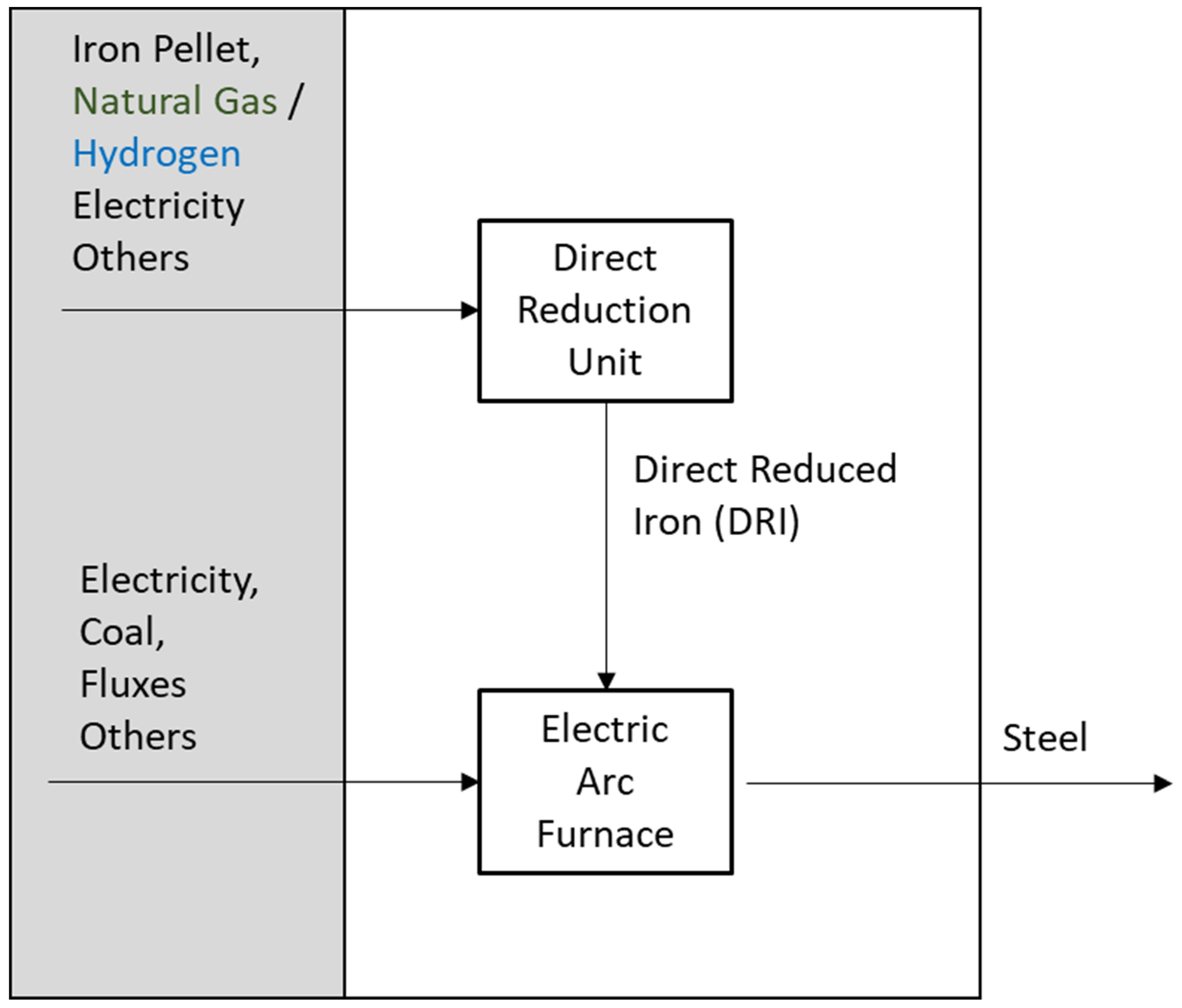
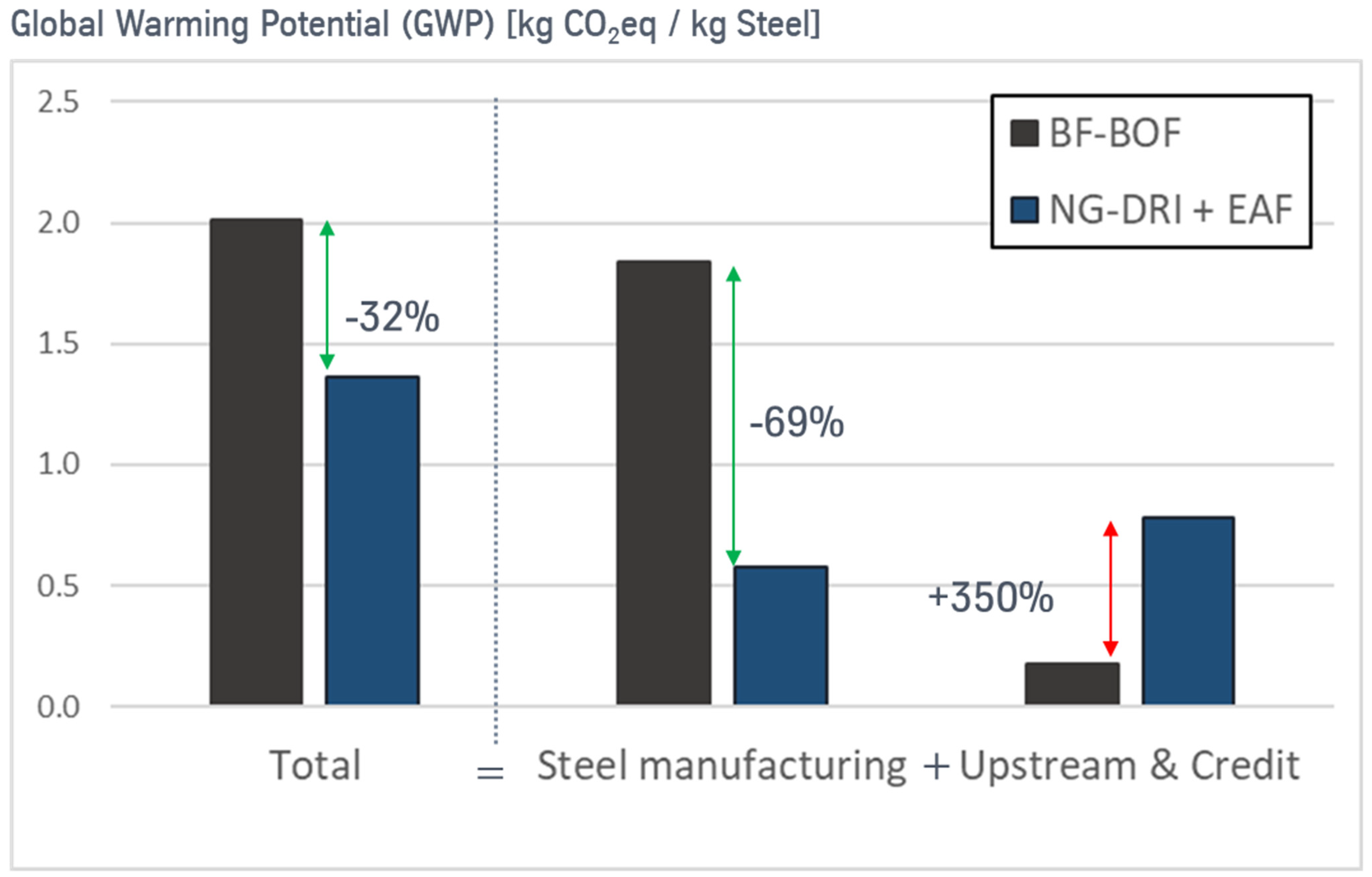
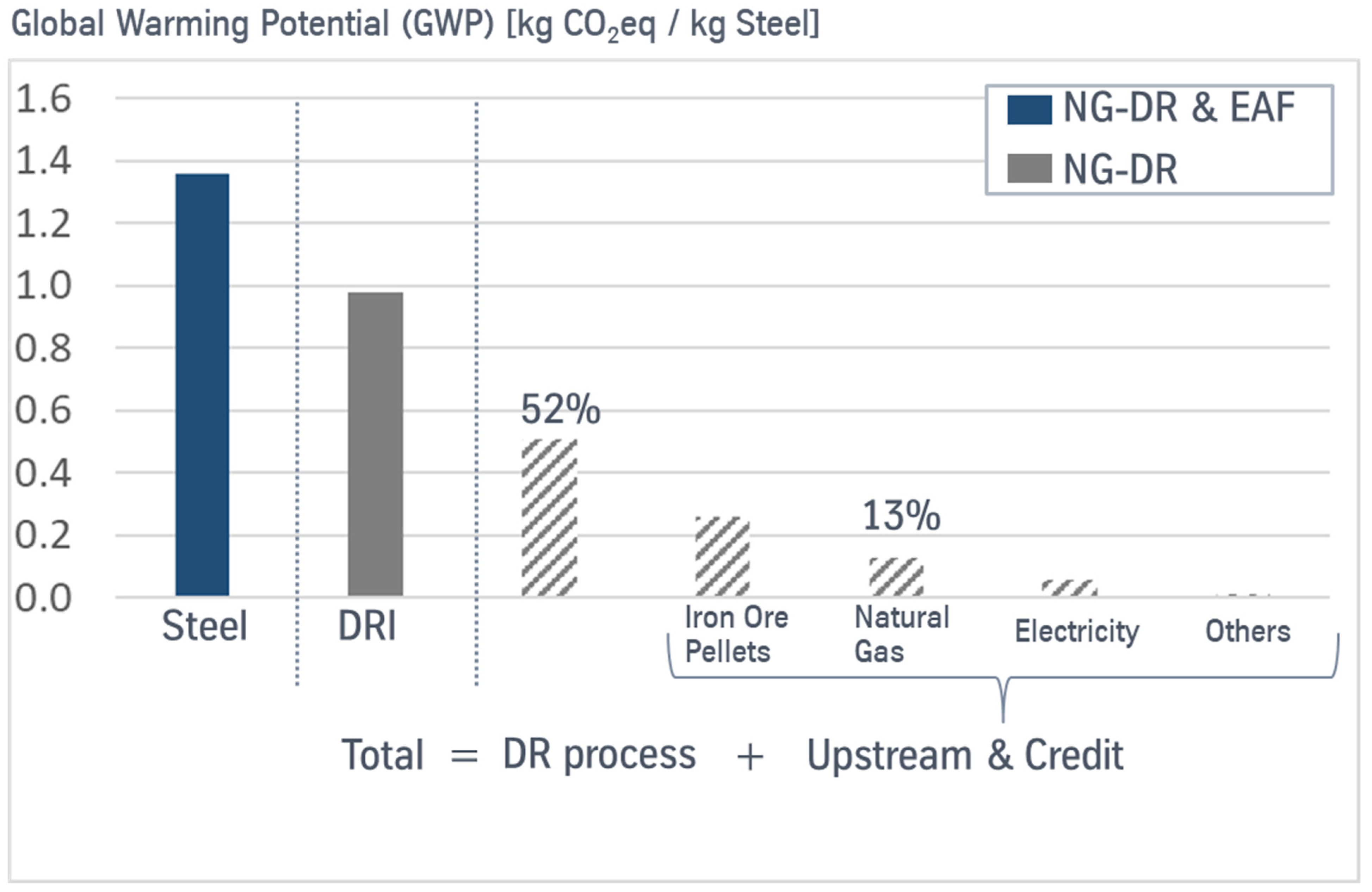

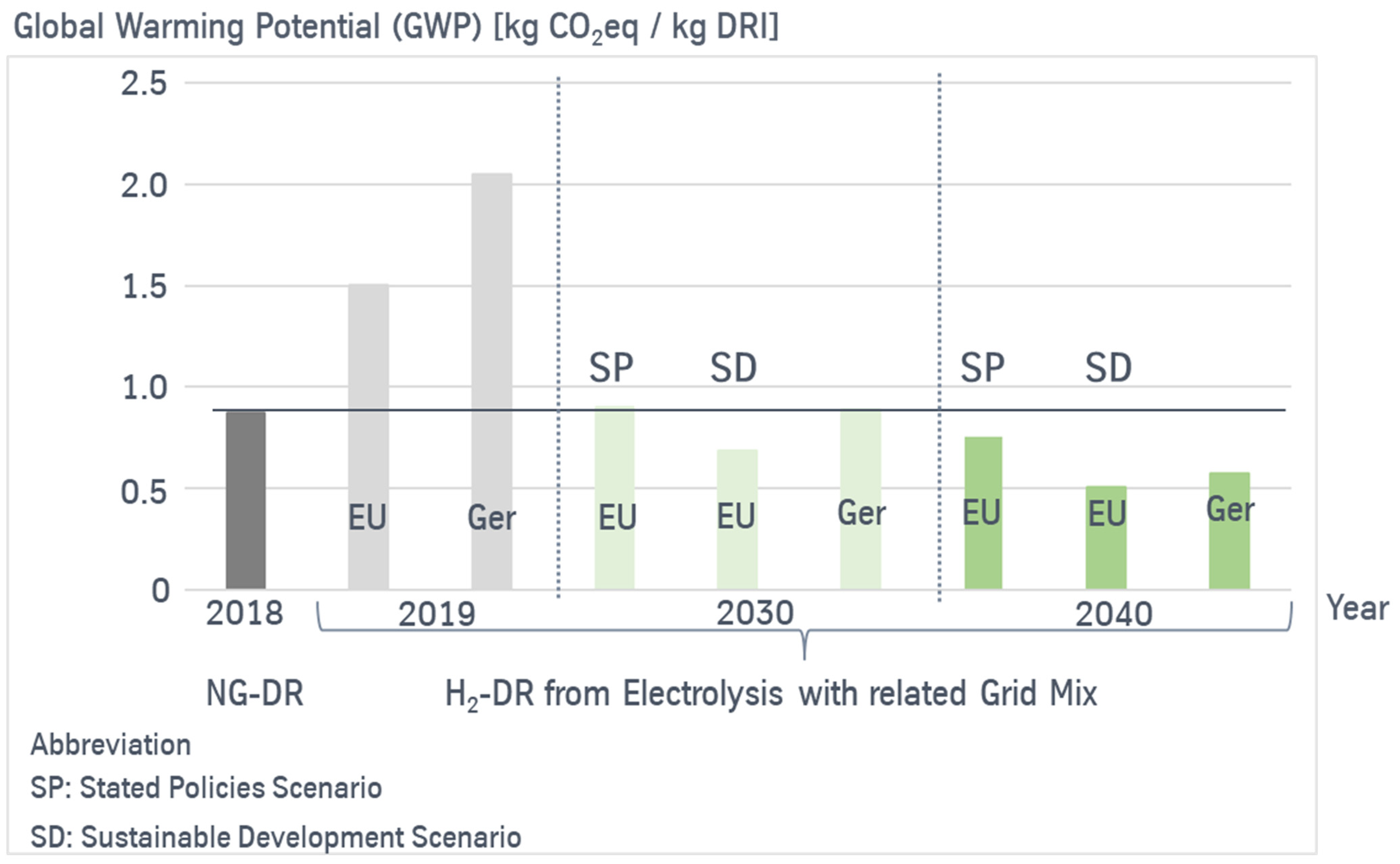
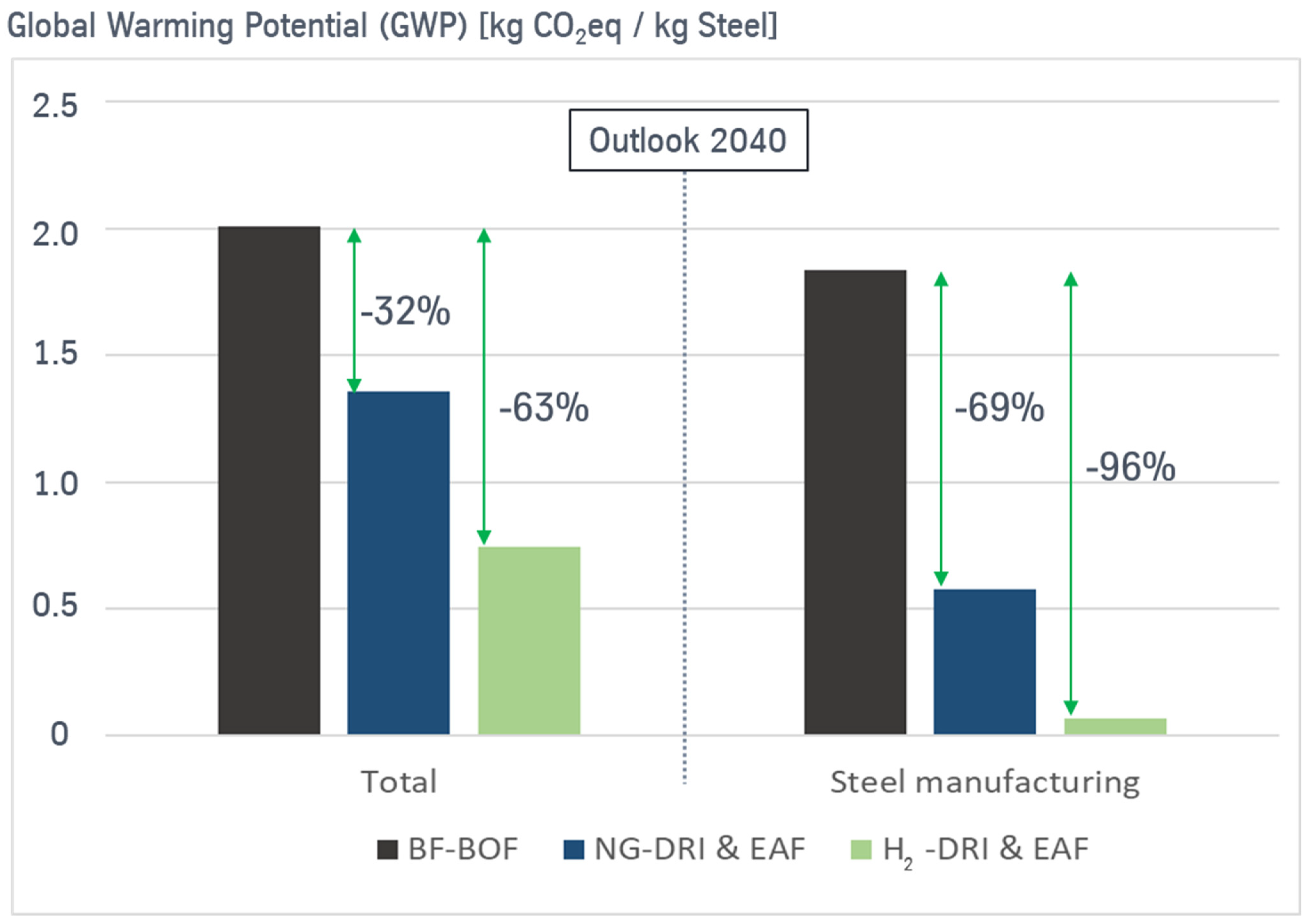
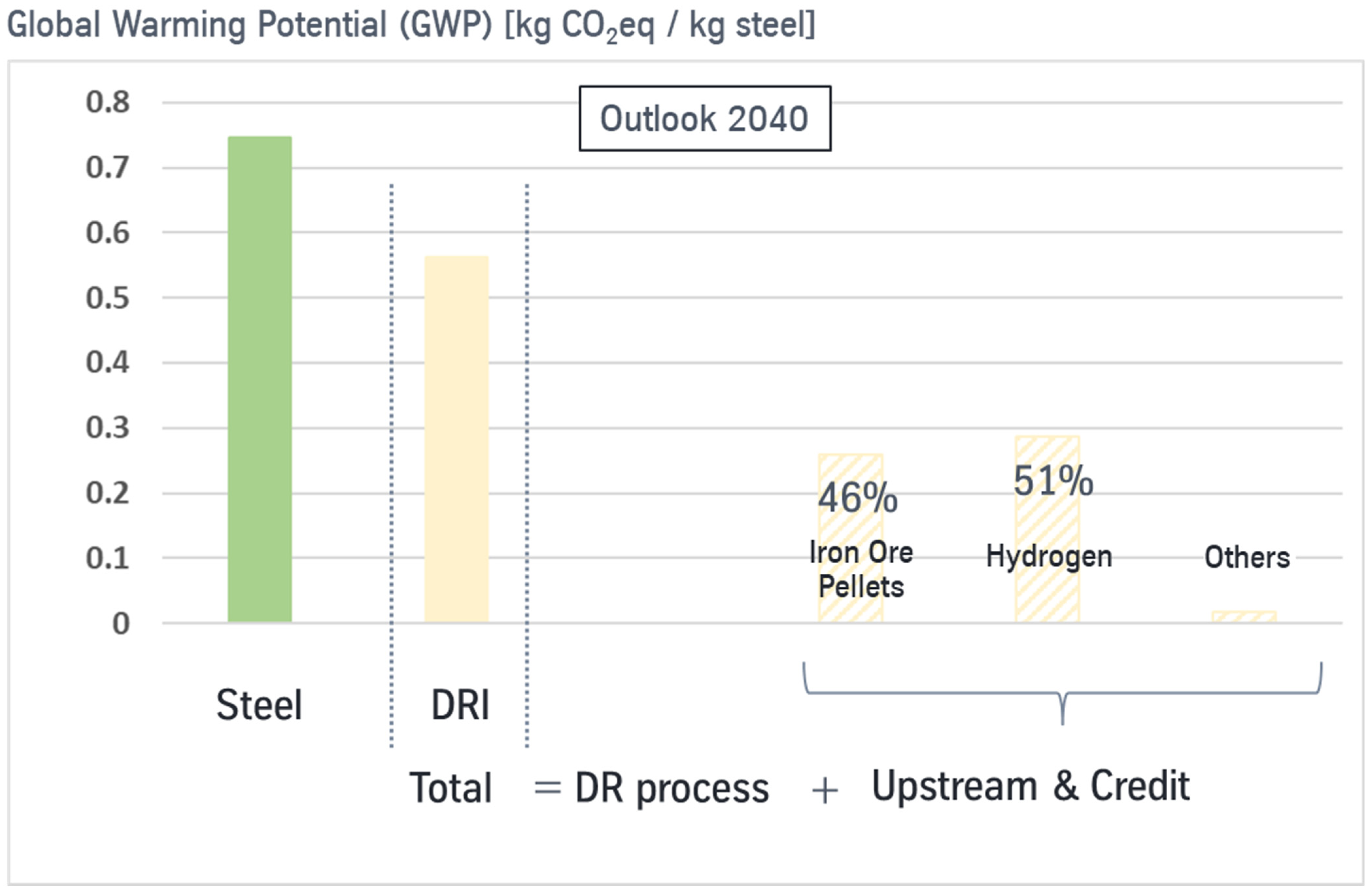
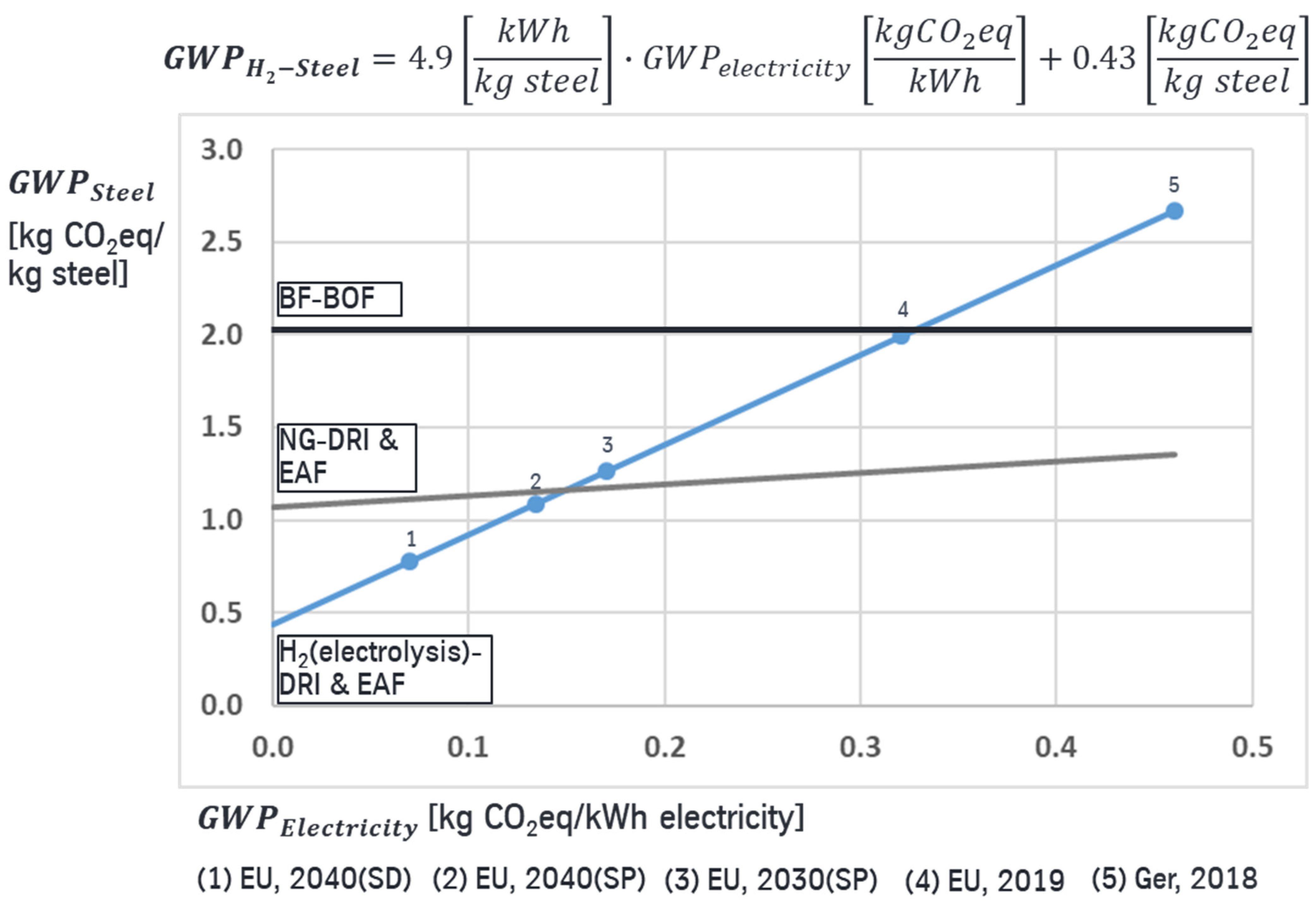
| Technology | GWP | Year of Data | Source | Comment on System Boundary |
|---|---|---|---|---|
| kg CO2eq/kg H2 | ||||
| Grey hydrogen from reforming process | ||||
| SMR a | 11.1 | 2021 | [11] | LCA b analysis according to GaBi database “DE: Hydrogen (steam reforming natural gas)” |
| SMR | 12.0 | 2011 | [22] | LCA of hydrogen production |
| SMR | 11.9 | 2012 | [23] | LCA of hydrogen production |
| SMR | 13.0 | 2017 | [24] | Holistic techno-environmental analysis |
| SMR | 12.1 | 2018 | [25] | LCA of hydrogen production |
| ATR c | 13.3 | 2025 | [26] | Includes natural gas production and transport |
| CG d | 22.7 | 2018 | [27] | Holistic approach |
| CG | 24.2 | 2018 | [25] | LCA of hydrogen production |
| CG | 19.0 | 2020 | [28] | Only directly related CO2 emissions; no upstream |
| Grey hydrogen from electrolysis driven by fossil-based electricity | ||||
| 35.0 | 2015 | [29] | Carbon footprint analysis; grid mix Netherlands 2015 | |
| 1.13 | 2015 | [29] | Carbon footprint analysis; grid mix Norway 2015 | |
| PEM e | 29.5 | 2018 | [25] | LCA of hydrogen production |
| SOEC f | 23.3 | 2018 | [25] | LCA of hydrogen production |
| 10.0 | 2025 | [26] | Grid mix Germany 2025; stated policy scenario | |
| 12.0 | 2025 | [26] | Grid mix Germany 2025; failed policy scenario | |
| Blue hydrogen from reforming with carbon capture and storage | ||||
| ATR | 0.64 | 2016 | [29] | Carbon footprint analysis |
| SMR | 1.73 | 2015 | [29] | Carbon footprint analysis; grid mix Netherlands 2015 |
| ATR | 2.55 | 2015 | [29] | Carbon footprint analysis; grid mix Netherlands 2015 |
| SMR | 3.40 | 2017 | [24] | Holistic techno-environmental analysis |
| SMR | 1.14 | 2018 | [29] | Carbon footprint analysis; grid mix Norway 2015 |
| ATR | 0.82 | 2018 | [29] | Carbon footprint analysis; grid mix Norway 2015 |
| SMR | 11–22 | 2021 | [30] | Carbon footprint analysis; focus on fugitive methane emissions |
| ATR | 4.67 | 2025 | [26] | Includes natural gas production and transport |
| Green hydrogen from electrolysis driven by renewable electricity | ||||
| PEM | 2.21 | 2018 | [25] | LCA of hydrogen production |
| Solar | 2.00 | 2011 | [22] | LCA of hydrogen production |
| Wind | 1.2 | 2011 | [22] | LCA of hydrogen production |
| Solar | 2.4 | 2012 | [23] | LCA of hydrogen production |
| Wind | 0.97 | 2012 | [23] | LCA of hydrogen production |
| Wind; SOEC | 5.10 | 2018 | [25] | LCA of hydrogen production |
| Year | Efficiency ηelectrolysis (%) Related to LHV a of Hydrogen | Electricity Input (MJ/kg H2) |
|---|---|---|
| 2018 | 60.9 | 197 |
| 2030 | 62.2 | 193 |
| 2040 | 63.4 | 189 |
| GHG Emissions | (kg/kWh Electricity) | (kg/kg Hydrogen) |
|---|---|---|
| Carbon dioxide | 0.44 | 24 |
| Methane | 1.1 × 10−3 | 0.058 |
| Nitrous oxide | 1.4 × 10−5 | 7.8 × 10−4 |
| Input | (Unit Input/kg Steel) |
|---|---|
| Iron ore (kg) | 1.5 |
| Natural gas (MJ) | 12 |
| Electricity (MJ) | 2.2 |
| GHG Emission | (kg Output/kg Steel) |
|---|---|
| Carbon dioxide | 1.3 |
| Methane | 0.0021 |
| Input | (Unit Input/kg Steel) |
|---|---|
| Iron ore pellets (kg) | 1.5 |
| Electricity (MJ) | 17 a |
Publisher’s Note: MDPI stays neutral with regard to jurisdictional claims in published maps and institutional affiliations. |
© 2022 by the authors. Licensee MDPI, Basel, Switzerland. This article is an open access article distributed under the terms and conditions of the Creative Commons Attribution (CC BY) license (https://creativecommons.org/licenses/by/4.0/).
Share and Cite
Suer, J.; Traverso, M.; Jäger, N. Carbon Footprint Assessment of Hydrogen and Steel. Energies 2022, 15, 9468. https://doi.org/10.3390/en15249468
Suer J, Traverso M, Jäger N. Carbon Footprint Assessment of Hydrogen and Steel. Energies. 2022; 15(24):9468. https://doi.org/10.3390/en15249468
Chicago/Turabian StyleSuer, Julian, Marzia Traverso, and Nils Jäger. 2022. "Carbon Footprint Assessment of Hydrogen and Steel" Energies 15, no. 24: 9468. https://doi.org/10.3390/en15249468
APA StyleSuer, J., Traverso, M., & Jäger, N. (2022). Carbon Footprint Assessment of Hydrogen and Steel. Energies, 15(24), 9468. https://doi.org/10.3390/en15249468







